

The Importance of Shared Identity and Purpose. By David Brubaker Since every congregation occupies a spectrum of beliefs and values, all congregations experience conflict.
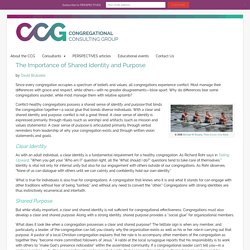
Most manage their differences with grace and respect, while others—with no greater disagreements—blow apart. Why do differences tear some congregations asunder, while most manage them with relative aplomb? Conflict-healthy congregations possess a shared sense of identity and purpose that binds the congregation together—a social glue that bonds diverse individuals. 5 Steps to Define a Nonprofit's Brand. Publisher's Site Every successful nonprofit is a brand.
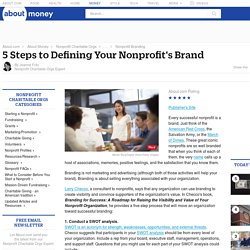
Just think of the American Red Cross, the Salvation Army, or the March of Dimes. These great iconic nonprofits are so well branded that when you think of each of them, the very name calls up a host of associations, memories, positive feelings, and the satisfaction that you know them. Branding is not marketing and advertising (although both of those activities will help your brand). Branding is about selling everything associated with your organization. Larry Checco, a consultant to nonprofits, says that any organization can use branding to create visibility and convince supporters of the organization's value. 1. Strengths - What do we do best? 2. 3. An example that Checco uses in his book is of affordable housing. To complete this step, you will need to survey a representative number of your audience and/or conduct a focus group. 4. 5. How to Write a Nonprofit Mission Statement. Mission statements have often been ponderous things, suitable mainly for an internal audience and to impress institutional funders.
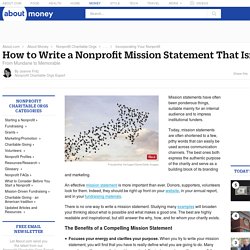
Today, mission statements are often shortened to a few, pithy words that can easily be used across communication channels. The best ones both express the authentic purpose of the charity and serve as a building block of its branding and marketing. An effective mission statement is more important than ever. Donors, supporters, volunteers look for them. Indeed, they should be right up front on your website, in your annual report, and in your fundraising materials. There is no one way to write a mission statement. 50 Example Mission Statements - Top Nonprofits. Mission Statement (What You Do): A one-sentence statement describing the reason an organization or program exists and used to help guide decisions about priorities, actions, and responsibilities.
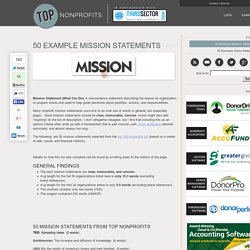
Many nonprofit mission statements succumb to an over use of words in general, but especially jargon. Good mission statements should be clear, memorable, concise. Some might also add “inspiring” do the list of descriptors. I don’t altogether disagree, but I find that including this as an upfront criteria often ends up with a frankenstein that is part mission, part vision statement (desired end-state), and almost always too long. The following are 50 mission statements selected from the top 100 nonprofits list (based on a series of web, social, and financial metrics). Details on how this list was compiled can be found by scrolling down to the bottom of the page. General Findings. 30 Example Vision Statements - Top Nonprofits. This exclusive content is sponsored by DonorDrive Definition Vision Statement: (Desired End-State) A one-sentence statement describing the clear and inspirational long-term desired change resulting from an organization or program’s work.

The following vision statements were selected from the top 100 nonprofits (based on a series of web, social, and financial metrics). Be sure to check out our Guide to Creating Vision and Mission Statements for more helpful tips. Details on how this list was compiled can be found by scrolling down to the bottom of the page. General Findings The best visions are inspirational, clear, memorable, and concise.Avg length for the full 30 organizations listed here is only 14.56 words (excluding brand references)Avg length for the first 15 organizations is only 10.5 words (excluding brand references).The shortest contains only three words (Human Rights Campaign)The longest contains 31 words (Amnesty International) What you do in seven words « The Butterfly Effect (Blog) « Cause & Effect. Posted by Jon Howard on July 11, 2011 The Trustees of Reservations saved Crane Beach for me. We spotted this message a half-mile ahead of the entrance to one of New England’s finest and least disturbed large coastal preserves in Ipswich, Massachusetts.
I don’t think I could say more with fewer words. (I would have made the name much bigger, but modesty suits the Trustees’ reserved Yankee demeanor.) My first thought: the perfect mission statement! The Eight-Word Mission Statement. Don’t settle for more.
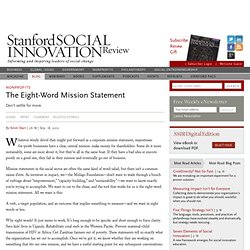
Whatever windy drivel they might put forward as a corporate mission statement, mainstream for-profit businesses have a clear, central mission: make money for shareholders. Some do it more sustainably, some are nicer about it, but they’re all in the same boat. If they have a bad idea or execute poorly on a good one, they fail in their mission and eventually go out of business. Mission statements in the social sector are often the same kind of word-salad, but there isn’t a common raison d’etre. As investors in impact, we—the Mulago Foundation—don’t want to wade through a bunch of verbiage about “empowerment,” “capacity-building,” and “sustainability”—we want to know exactly you’re trying to accomplish.